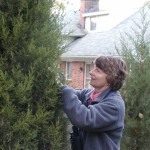For general inquiries and issues, email us by clicking here: info@backyardsfornature.org
To email Edie Parnum, click here: edie@backyardsfornature.org

To email Barb Elliot, click here: barb@backyardsfornature.org

For general inquiries and issues, email us by clicking here: info@backyardsfornature.org
To email Edie Parnum, click here: edie@backyardsfornature.org

To email Barb Elliot, click here: barb@backyardsfornature.org
Hey Barb,
I picked up a management job in a town called Middleburg, PA. Right now we’re doing an overhaul of an old restraunt. It will soon be a cafe, candlemaking shop, and retail outlet for candlemaking supplies. While doing the work I have located 3 birds nests. The first nest was on the grill exhaust fan and had to be removed to clean the unit. It did not look like it had been used for a while so I did not feel I was displacing any birds. The second nest I located was above the front door, sitting on a beam underneath the roof. When I went to remove that nest I noticed it had 3 little blue eggs in it so I placed the nest right back in its home and showed the owner and she said we will keep it there till the babies grow up and leave the nest. The third nest is located in an exhaust pipe and must be removed. My question to you is what should I do with nest 1, and nest 3. I was thinking about relocating them into the woods because you have told me birds will move in so to speak. My other thought was bringing them all the way back to my property to see if some other birds will take up residency there. I figure this is the right place to put my questions and maybe u could guide me on if this is a worthwhile venture!
Hi Dustin. Thanks for caring about the birds and their nests. It’s great that you left the nest with the eggs and got the owner to agree to leave it in place until the birds fledge. With the exceptions of House Sparrows and European Starlings, which are not native to North America and are not protected, it’s actually against the law to interfere in any way with an active bird nest. Here is info about this from the Cornell Lab of Ornithology’s website : “Under the Federal Migratory Bird Treaty Act it is illegal to take, possess, import, export, transport, sell, purchase, barter, or offer for sale, any migratory bird, or the parts, nests, or eggs of such a bird except under the terms of a valid permit issued by federal and, in some cases, state agencies. Additionally, many species are protected by other state and local laws. Therefore, in most instances it is illegal for you to touch or otherwise physically disturb an active nest or its contents.”
Regarding your re-locating the two cup nests that are no longer active, I think you should probably discard them. Most species of birds will not re-use a cup nest and the nest material sometimes harbors parasites that can prey on future nestlings. If you’d like to help the birds by providing nest materials in your yard, this website has some helpful hints about materials you can provide: http://www.allaboutbirds.org/page.aspx?pid=1144 By doing this, you may be able to get a bird to nest in or near your yard.
Barb
Barb, thank you for your thoroughly comprehensive overview of pollinators and our role in supporting them. That pollinators such as monarchs and bees are in serious decline is discouraging, You and Edie will be offering milkweed plants again this year, thank you! It’s so important that we not give up.
Thanks, Joan. Yes, it is very important that we not give up on the Monarchs or other pollinators. The smaller the number of Monarchs that return, the more milkweed we need to provide — so they can find it more easily. As I know you know very well, planting more native plants is the most important single thing we can do to help sustain bee and other pollinator populations.
Barb
Hi Barb….
I just came across your 9/30/2016 post while checking out Virgin’s Bower Clematis. Just found out they are dioecious, wondered if male plants produce nectar as well as pollen. I’ve seen many bees and wasps of all sizes but whichever it is it doesn’t produce seed. I’m sure no others live nearby: I live in an urban garden desert pretty much. But the reason I write is because of your wonderful pics of hawkmoths and their larvae. I’ve had Hemeris thysbe in my yard and a friend has them pretty frequently. Wondering what state you live in to have so many other species? What lens do you use for the terrific closeups?
Hi Jeannie. Thanks for your comment. Sorry for the delayed reply. I live in Pennsylvania. The camera I used for the closeup photos is a Panasonic GX8 with a 45mm Leica macro lens. The GX8 is a mirrorless digital camera.
Thanks for reading the blog!
Barb Elliot
Your post about tree bark is fascinating! It makes sense that there’d be a purpose to shaggy bark, but it wasn’t on my radar. I love staring at old trees, especially ones with shaggy or ragged bark. Now I can wonder who’s enjoying a special treat!